#Alfonso Carracci
Explore tagged Tumblr posts
Text




#the way she says 'ciao alfo' is soooo soft... i can't with them...#l'amica geniale#elena greco 📝#alfonso carracci#letters from stephanie*
10 notes
·
View notes
Text


"How does one get across the fact that the best way to find out how people feel about their gender or their sexuality—or anything else, really—is to listen to what they tell you, and to try to treat them accordingly, without shellacking over their version of reality with yours?"
-- "The Argonauts" by Maggie Nelson
#elena ferrante#l'amica geniale#my brilliant friend#alfonso carracci#maggie nelson#the argonauts#transgender#lgbtqia#queer
82 notes
·
View notes
Text


I don't think I fully understood what it meant that Alfonso looked like Lila until I saw them on screen side by side... uncanny
68 notes
·
View notes
Text







L'amica geniale season 4: came for the plot stayed for Kartell furniture and major 80's fashion moments
#my brilliant friend#season 4#hbo#lila cerullo#elena greco#alba rohrwacher#irene maiorino#the neapolitan novels#elena ferrante#l'amica geniale#80's#fashion#interiors#alfonso carracci#mine
30 notes
·
View notes
Text
still thinking about lenu and alfonso's scene in the car </3
#the way alfonso started tearing up while telling lenu everything aaaa#alfonso carracci#elena greco#l'amica geniale
12 notes
·
View notes
Text


Great, great passage, with some flashes of genuine insight finally working their way into Lenù's usual self-talk. The Alfonso stuff is really starting to pay off.
#l'amica geniale#my brilliant friend#elena ferrante#monstrousgourmandizingcats reads l'amica geniale#lenùposting#alfonso carracci
4 notes
·
View notes
Text

Reggio Emilia - Sala del Tricolore - 1796
1452: Borso d’Este von Ferrara ernennt zum Herzog von Modena und Reggio. Maler wie Cosmè Tura, Francesco del Cossa und Ercole de’ Roberti waren am Este-Hof aktiv.
1470: Die Fresken im Palazzo Schifanoia mit astrologischen Themen sind ein typisches Werk der ferraresischen Schule. Ercole de Roberti war ein typischer Maler der Renaissance mit ordentlichen Zeichnungen und klaren Farben, während Cosmè Tura als Vertreter des dramatischen Stils mit bizarren Figuren gilt. Die Darstellung des Monats September von Cosmè Tura kombiniert mythologische und astrologische Motive (Vulkan) mit Turas charakteristischem dramatischen Stil, reichhaltige Ornamente, metallische Farben
1471: Ercole I. d’Este. Addizione Erculea in Ferrara mit Palazzo Diamanti (Biagio Rossetti), ein Meisterwerk der Renaissance-Architektur, dessen Fassade mit einer Diamantmuster-Steinverkleidung versehen ist. Förderung von Künstlern wie Piero della Francesca und Ludovico Ariosto. Isabella d’Este war die Ehefrau von Francesco II. Gonzaga, Herzog von Mantua, und Mutter von Federico. Sie war eine der bedeutendsten Adligen der Renaissance.
1474: Ludovico Ariosto wurde in Reggio geboren. Sein Stil gilt als typisch für die Renaissance, geprägt von Fantasie und der Fähigkeit, erzählerisch komplexe Themen zu behandeln. Er greift höfische, ritterliche Motive des Mittelalters auf und verbindet sie mit humanistischen Idealen. Er vermischte traditionelle Ritterthemen mit Elementen von Ironie, Humor und Fantasie, was einen Bruch mit der ernsten und idealistischen Darstellung früherer Epen darstellt. Während Autoren wie Dante moralische und religiöse Botschaften in den Vordergrund stellten, konzentrierte sich Ariosto auf Unterhaltung und die Kunst des Geschichtenerzählens.
1478: Pazzi-Verschwörung
1481: Santa Maria in Porto von Ercole de’ Roberti
1490: Isabella d’Este (Tochter von Ercole I.) heiratete Francesco II. Gonzaga, den Herzog von Mantua.
1494: Durch die Unterstützung in 1494 von Karl VIII. von Frankreich konnte Ercole I d’Este seine Unabhängigkeit sichern und seine Stellung in Norditalien stärken.
1502: Alfonso d’Este verheiratet mit Lucrezia Borgia, was die politische Macht der Este stärkt.
1505: Alfonso I. d’Este Herzog. Verteidigt Ferrara erfolgreich gegen den Papst und Frankreich während der Italienischen Kriege. In späteren Phasen der Italienischen Kriege (1520er Jahre) unterstützte Alfonso Karl V., Kaiser des Heiligen Römischen Reiches, gegen Frankreich. Diese Allianz sicherte Ferrara langfristig ab. Er war Freund mit Giovanni Maria Boiardo und Ludovico Ariosto der widmete dem Orlando Furioso ihren Bruder, der Kardinal Ippolito I d’Este.
1512: Schlacht von Ravenna zwischen Alfonso I. d’Este und Papst Julius II.
1519: Nach dem Tod Herzogs von Mantua, Isabella d’Este übernahm die Regentschaft für ihren minderjährigen Sohn Federico II. Gonzaga und sicherte die Stabilität des Herzogtums. Sie sammelte antike Skulpturen, Schmuck, Manuskripte und ließ zahlreiche Kunstwerke für ihre berühmte Studiolo (ein privates Kunstkabinett) anfertigen.
1526: Giovanni delle Bande Nere starb während des Krieges zwischen Kaiser Karl V. und den Papstum. Er wurde durch eine Kanonenkugel verwundet, eine Waffe der neuen Artillerie, und erlag später seinen Verletzungen. Die kaiserliche Armee, die später 1527 den Sacco di Roma ausführen sollte, wurde von Alfonso I. d’Este und Federico II. Gonzaga unterstützt.
1534: Ercole II d’Este
1559: Alfonso II. d’Este. Alfonso II. d’Este heiratete die Tochter von Cosimo I. de’ Medici, um die Allianz zwischen den beiden Familien zu stärken. Doch sie hatten keinen Sohn, und schließlich fiel Ferrara an den Kirchenstaat.
1572: Der Kardinal Ippolito II d’Este ließ die Villa d’Este bei Tivoli erbauen und weihte sie ein
1598: Cesare d’Este. Ferrara fällt an den Kirchenstaat. Die Este verlegen ihren Herrschaftssitz nach Modena und Reggio
1614 - 1648: Die Carracci spielten eine indirekte Rolle in der Dekoration der Basilica della Ghiara, einem wichtigen religiösen und künstlerischen Zentrum in Reggio Emilia. Die Carracci perfektionierten die Technik der Quadratur, bei der illusionistische Architekturelemente in die Fresken integriert wurden, um die Illusion von räumlicher Tiefe zu erzeugen. Michelangelo und Raffael gelten als Höhepunkte der Renaissance. Ihre Stile wurden von späteren Malern wie Caravaggio und den Carracci weiterentwickelt. Der Erste (Caravaggio) übernahm den dynamischen Ansatz Michelangelos, während die Zweiten (die Carracci) den Naturalismus Raffaels aufgriffen. Giulio Romano ein Hauptschüler Raffaels, aber er war für seine monumentalen Fresken und dekorativen Innovationen bekannt.
1621: Francesco I. d’Este. Gleich zu Beginn seiner Herrschaft sah er sich mit der schweren Pestepidemie von 1630–1631 konfrontiert, die einen Großteil der Bevölkerung Modenas dahinraffte. Francesco führte mehrere militärische Kampagnen durch, darunter die Invasion des Herzogtums Parma während des Dreißigjährigen Krieges. Er förderte die kulturelle Entwicklung seines Herzogtums, indem er bedeutende Bauprojekte wie den Herzogspalast in Modena initiierte (1634) und Kunstwerke von Künstlern wie Gian Lorenzo Bernini und Diego Velázquez in Auftrag gab.
1631: Ehe von Francesco I. d’Este, Herzog von Modena und Reggio, mit Maria Farnese, Tochter von Ranuccio I. Farnese, Herzog von Parma und Piacenza. Die Farnese begannen ihre Geschichte als Soldaten und Verwalter im Dienst des Papsttums, bis Alessandro Farnese im Jahr 1534 zum Papst gewählt wurde und den Namen Paul III. annahm. Während seines Pontifikats machte er seinen Neffen Pier Luigi Farnese im Jahr 1545 zum Herzog von Parma und Piacenza. Später wurde Herzog Alessandro Farnese, ein Nachkomme der Familie, Heerführer in Flandern im Dienst von Philipp II. von Spanien.
1635: Während des Dreißigjährigen Krieges (1618–1648) war Norditalien ein Schauplatz regionaler und internationaler Konflikte. Francesco I. führte Truppen gegen das Herzogtum Savoyen-Piemont, das sich auf die Seite Frankreichs gestellt hatte.
1695: Rinaldo d’Este
1741: Francesco III. d’Este. Bau des Herzogspalastes in Modena. Im Jahr 1765 ernannte Maria Theresia von Österreich Francesco III. d’Este zum Herrn von Varese, wo er die Gärten anlegen ließ.
1796: Im Jahr 1796, kurz bevor Napoleon in Mailand einmarschierte, floh Herzog Ercole III. von Modena nach Venedig. In dieser Zeit wurde die Reggiana Republik gegründet, deren wichtigstes Ereignis die Schlacht von Montechiarugolo war, bei der die Bürger von Reggio die Österreicher besiegten.” Das Herzogtum wird später Teil der Cispadanischen Republik.
1814: Francesco IV. von Habsburg-Este. Nach dem Wiener Kongress erhalten die Este-Modena ihre Herrschaft zurück.
1831: Francesco IV. hatte zunächst versprochen, die Anliegen der Carbonari zu unterstützen, stellte sich jedoch letztlich als ein reaktionärer Herrscher heraus. Ciro Menotti, ein führender Kopf der revolutionären Bewegung, wurde inhaftiert und 1831 hingerichtet.
1859: Francesco V. von Habsburg-Este. Modena wird in das Königreich Sardinien eingegliedert und später Teil des vereinten Königreichs Italien.
0 notes
Note
Hi! How would you describe the dynamic between Alfonso and Lila, and how in your opinion Lila sees Alfonso? He is one of the few character in Lila's life that I've not really understand, and I remember that you have written some post about him, so I thought I could ask your opinion on his relationship with Lila.
I am finally on vacation so I can answer this with the attention and care it deserves!
LILA AND ALFONSO - THE (QUEER) FRIENDSHIP THAT HAPPENS OFF-SCREEN
[Warning: SPOILERS for book 4 of MBF. Also warning: Massive post. Read it with coffee or tea].
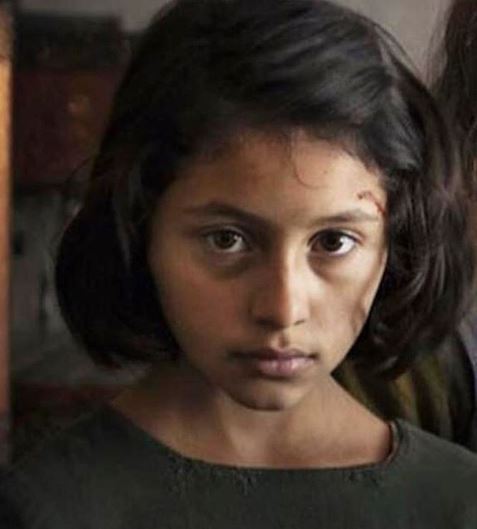
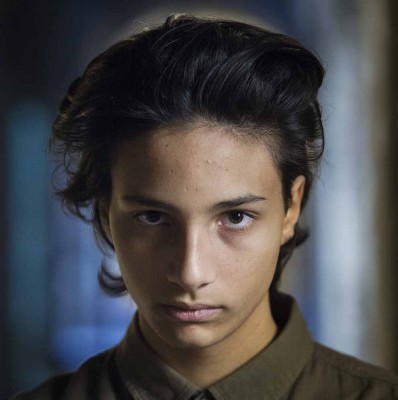
So! What do we know about those two? Lila is our beloved, the Heroine of the 1,000 Faces, someone you can read as cruel or kind, mischievous or honest, intuitive or logical, and it all makes sense because she's all that and more.
Alfonso is our only (open) LGBTQ+ Representative in Town and thus his portrayal is more stereotypical. As MBF aspires to be an all-encompassing tour of the greatest movements and ideologies of the Twentieth Century (the saga is truly as humble as its two main characters), there is a character who stands as a representative of each of them. For example, Mariarosa stands for the women's rights movements (all of them) and the sexual revolution of the 60's-70's. Pasquale stands for communism, class consciousness and resistance to state mechanisms (quite a lot to stand for as well). Lila and/or Lenù will be more or less influenced by all of these movements without ever labeling themselves as anything.
Alfonso stands for the then-called gay liberation movement and social rights. He's one of the very few men in the series who isn't a testosterone vessel with a traditional "masculine" role. He's soft and shy, a do-gooder, and as much of a people-pleaser as Lenù. He's intelligent and interested in languages, but he also has a hedonistic streak. He has some traits in common with Lenù, but without her ambition and perfectionism. He might arguably be what Lenù have resembled without Lila in her life.
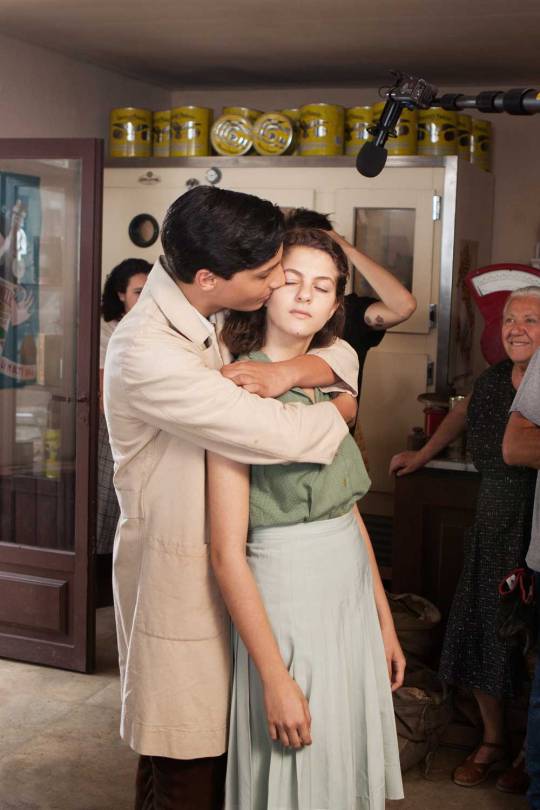
Alfonso and Lenù start a friendship on their teens, which is uncommon at the time, as no one expects a boy and a girl to be just friends. They talk a lot, enjoy each other's company and sit together in class. Lenù finds Alfonso very handsome (1) and wonders whether there's anything more on his side. Lenù being Lenù, I'm guessing that she wasn't exactly difficult to read, and that might've made Alfonso a bit wary. He already has another girl friend, Marisa Sarratore, who expects more of him and whom he initially uses as a cover - two may have been too much.
At the same time, Lila is now Stefano's young wife, and this has probably started a new dynamic between Alfonso and Lila, even if it's just because they are family. We know that Lenù comes up often in their conversation, e.g., when Lila asks Alfonso to bring Lenù to her place so she will have a place to study. This will be the model of their whole relationship - Lila commands, Alfonso obeys. Still, there seems to be a growing intimacy between them, even if Lila is mostly interested in passing messages to Lenù through him at this time.
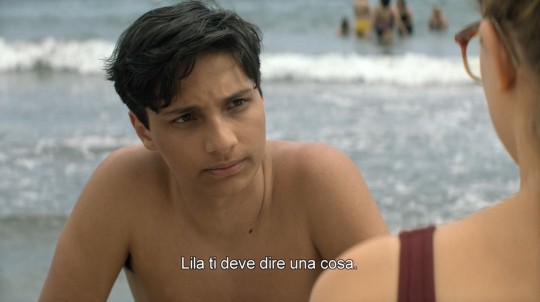
When Lila creates her own "artwork" and hangs it on the shoe shop, Alfonso is mesmerized (this happens on the book only). He happily kisses her cheeks and claims, "I always knew you were dangerous". I love the subtext of this scene. What Lila has done with her own picture is an act of deconstructing her body. She's ripping open her heteronormative self (literally dressed as a bride) and creating something different out of the pieces. The result is defiant, seductive, an image that is both vanguardistic and excessive, and all the straight-coded characters feel immediately threatened and repulsed by it. This is the blood and bone of the queer and most specifically the transgender experience; what Lila has done in a bout of rage/enthusiasm has an extremely queer reading just because of the act itself (2). Hence Alfonso, who is probably starting to find out who he is on that side of the town, is telling her: "You and I are birds of a feather! I always knew!".

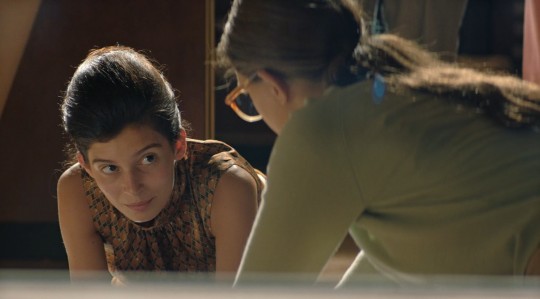



At that point, Lila claims not to understand Alfonso's words, but she surely knows that Alfonso is Different, Not Like Other Men, and that he's reluctant to Behave As Expected with women. Lila is trying hard to conform to the rione's standards as Stefano's wife and she's finding it very difficult to Behave As Expected, both in and out of the bedroom. The idea that she may somehow be like Alfonso, someone who can't fit in because of who he is, may be very discouraging for her.
Alfonso: "We were two strange bodies inside the Carracci family".
So Lila is the first one to start cheering and clapping when Marisa kisses Alfonso on Rino and Pinuccia's wedding, a situation that was clearly embarrassing for him. We already know that Lila can be mean when she's annoyed, so I'm guessing that this was done on purpose. Not much later she will admit to Lenù that she was wrong - without specifying what was so wrong with her behavior that day (3). It is also suggested that Lila may have contributed to spreading the rumors about Alfonso being gay - we'll never know.
Despite these hardships, Lila and Alfonso's relationship evolves (because Alfonso is a cookie and won't stay mad at her), and at some point they have a conversation that gets more intimate than the others: he comes out to her as "ricchione" (4). They don't talk about queer sensibilities or gender questioning yet, only about attraction. Lila is the first person he discusses this at length with, though he's most likely had some experiences with men before.
It's not clear when this happens. My best guess is when Lila and Alfonso kind of overlap at the shoe shop. At this time, Alfonso is contemplating whether he should marry Marisa, while Lila is involved in an all-consuming affair with Nino (without Lenù to talk to). Love is a bit of an Achilles' heel for Lila; we know that affection makes her vulnerable. Did she and Alfonso have a heart-to-heart in the shop? Did Lila only listen, or did she also share any secrets in exchange? I can definitely picture them in intense conversation when alone and then playing siblings-in-law in the company of others. Consider also that when Alfonso looks back to this event, it's with a sense of hope and relief, and he seems to know Lila pretty well afterwards (5). Whatever Lila said, it wasn't judgmental - she probably encouraged him to do whatever the fuck he wanted. Lila is usually more cautious, so this reinforces my idea that she was living her romance with Nino at the time.

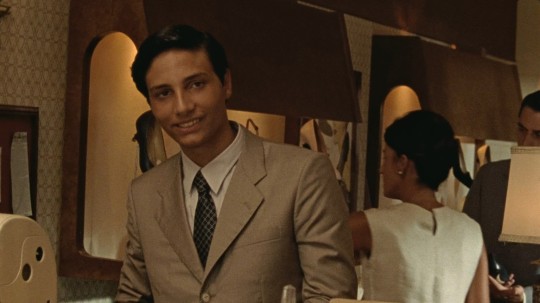
As stereotypical as it may be, there is a classic dynamic in the friendship between a girl and a gay guy - for him, she might be easier to forge a connection with, and for her, he might be a gate to a different sensibility. This may have been the case for Lila and Alfonso (6). The burgeoning friendship may have come as a relief for both of them, but especially for Lila, who is trapped in a heteronormative world, sexualized by everyone and almost always chased by men. Alfonso looks up to her and finds her gorgeous, but he doesn't want to sleep with her, and it's not just the looks he admires - he wants the attitude, the whole personality, and unlike Lenù, he openly recognizes this effect that Lila has on him. This naïveté may have been very touching to Lila, who is, at the bottom of her heart, pretty hungry for acceptance and unconditional love.
However, Alfonso is unwilling to help Lila in any way that may be confrontational for his family or his employers (probably scared that they would turn onto him as well), and that tiny bit of a "relief through nice conversations when alone :)" is not enough. Thankfully she has Lenù Enzo, who proves to be (mostly) the only one who is willing to risk his life for her.
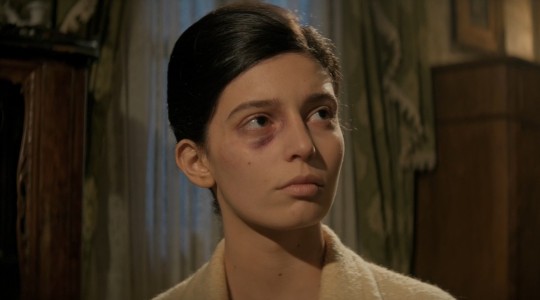

Alfonso: "If I'd been born a woman, I'd have wanted to be like her".
When Alfonso decides to take Michele's "advice" and marry Marisa, he's probably already very taken with Michele - he tells that to Lila not much later. To Lila, this is extremely helpful, as she's already planning how to get the most out of Michele without having to become his lover. As much as Lila loves certain people, she also harvests utilitarian relationships, especially within the rione. The plan they come up with seems to benefit both of them - Alfonso gets Michele, Lila gets Michele's money and influence.
The "seduction" of Michele comes with Alfonso dressing as a woman and adjusting her appearance more and more to look like Lila. It's not just a trick, but a true desire of Alfonso's, who is uncomfortable with his appearance and wants to look more womanly. It's never clear whether Alfonso is actually transgender or not, and I have found a lot of confusion in MBF-related texts. In favor of this idea, the narrative seems to be encouraging the fact that (s)he has "a woman's soul", and it is said that (s)he refers to her/himself in feminine form at times (Lenù changes forms a couple of times in her mind when she sees how much (s)he's changed). Many people that we consider transgender now didn't self-identify as such at the time. However, the queer community has always mixed up gender identities; also, Alfonso never seems to go by any other name, something that would clearly represent her/his rebirth as her/his new female-presenting self. To me, Alfonso seems to be embracing gender fluidity as a traditional feminiello, but that's the problem of standing for all the LGBTQ+ letters in one single character. For clarity reasons, I will keep on referring to him as a "he", though it might be more accurate to use other forms.
At the beginning, Lila seems to have her reluctancies with this process of Alfonso, as if this new persona of his could be no more than a grotesque imitation of a woman from a man's point of view ("you can copy me but my shit will always be mine"). HOWEVER! Just as Lila changed her mind regarding Being Queer, she quickly drops the terfy mindset, gets into the gist of Alfonso's Makeover and becomes collaborative (one cannot use the world "enthusiastic" when it comes to Lila).
This change of mind is not surprising, as both Lila and Lenù love games and they are very much attracted by the queer narratives of transforming/becoming ("diventare"). There is this scene where Alfonso, Lila and Lenù are shopping for clothes. Lila chooses (women's) clothes for Alfonso as if they were for her, and Alfonso, in turn, tries them out as if he was her. The fact that even the shop owner is a "ricchione" emphasizes the playfulness and queerness of the scene, where everyone seems to be having a lot of fun except for Lenù, who is a bit awkward. If people tend to see Lila as less heteronormative than Lenù, it's because of these scenes - because even if Lila never does much herself, and even without direct contact with any kind of world but her small neighborhood, she seems to be potentially willing to partake in stuff that leads her off the paved path (7).

Still, Lila being Lila, she always treats Alfonso with a sense of superiority, like she can boss him around and dispose of his time as she wants, especially when he becomes her and Enzo's employee at Basic Sight. She jokes that Michele is chasing "the shadow of [her] shadow" (meaning Alfonso). This treatment of Alfonso by Lila isn't much different from the way Lila treats almost everyone, including Lenù, who is often irritated by her domineering ways. Lila seems to follow a similar pattern with most of the people she loves - treat with contempt first, panic afterwards if they seem too tired of her, and quit everything and help if they are in need.
But I get annoyed at the narrative at this point because the purpose of the seduction is to make a puppet of Michele by making him do TEH G4Y. This leaves Michele confused, though this version of his actually seems much nicer. But he's watered down, less of a man now; he's gone "crazy". I get that passion makes you do irrational things -take both Lila and Lenù with Nino-, but the way this relationship is handled gives me the creeps. The fact that Alfonso and Michele are the only two characters openly DOING TEH G4Y, while the two leads often walk down the border of the THOUGHTS OF TEH G4Y but never come down to "doing" anything, seems to recall a former time when the "4ctions" were the only thing that mattered for queerness, and it was OK to feverishly long for your friend as long as you never did anything about it (8).
When Michele finally manages to break up with Alfonso and gives him a brutal beating as a final gift, Alfonso is heartbroken. He starts not showing up at work, being gross and overtly sexual in front of the children (9), and seeming confused with her own male/female self. He basically crawls down the deep dark well of the G4Y, and, in essence, this stereotypical downfall matches Lila's. Alfonso also wants to run away from his own body (Lenù's words) and escape toxic masculinity, which in his case is also creeping from the inside. In the end, Alfonso dies, probably murdered by Marcello in retaliation for his involvement with his brother, as Alfonso himself had warned it would happen. So, in a way, it is toxic masculinity and corruption under the façade of respectability what gets him killed.

Lenù: "She reached out to him as if he were a mirror to see herself and extract from his body a part of herself".
Lest aside the queerphobia of Alfonso's storyline, his strong bond with Lila remains (and, to a lesser extent, with Lenù). Lila could've fired Alfonso when he started being unreliable, but she didn't. On the contrary, she and Enzo supported him, even though he may have cost them precious money (10). When Alfonso is killed, Lila is heartbroken, to the point of neglecting her daughter for a while. Lenù realizes that her relationship with Alfonso must've been way more intense than what it seemed on the surface. This abounds in Alfonso's parallelisms with Lenù as some kind of "living matter" that Lila uses for the tasks that she can't (or won't) do herself, be it writing books or being openly queer fully changing her appearance so that it matches the inside. Also, Lila probably feels very guilty about Alfonso's demise for the role she played as the instigator of Alfonso's "feminization" and Michele's seduction (11).
What did Lila and Alfonso talk about when they were alone? Did she let herself be silly and have fun with him? Did she find in him the pure and simple adoration she once got from Lenù? Did she play him for her profit, or did she just play the role that Alfonso urged her to play? There are very few instances of "pure" friendship in My Brilliant Friend and I think we are all left a bit starved in that respect. I'd like to believe that Lila and Alfonso were probably friends in the purest sense of the word, each of them finding in the other a hand to reach out for, and the confidence to do the things you already want to do, in a strange world.
Phew, this was lengthy but fun! Who's next? Elena and Mariarosa? Lila and Pasquale? I'm up for all of them!
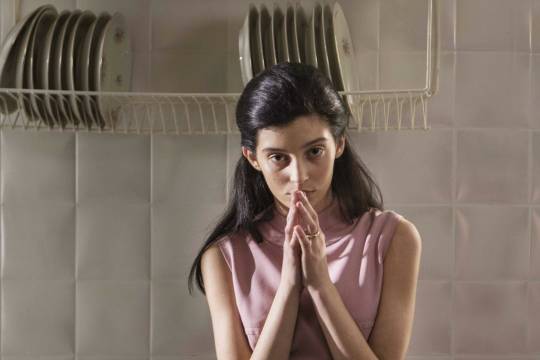

---
(1) What a coincidence that Alfonso ends up resembling Lila!
(2) Lila, by the way, shares the execution of her queer artwork with a very willing Lenù, who picks up on the performative/playful nature of the act instinctively.
(3) Lenù complains of Lila being a pain in the ass and giving her trouble but she actually loves Lila being silently non-conforming and Not Traditionally Womanly, and rabidly dislikes when she acts like everyone else in the rione. She needs Lila to be the odd one out (instead of her) just as much as Lila needs Lenù to fit in and triumph in a male-dominated world (instead of her).
(4) "Ricchione", meaning both homosexual and queer, is the only word that Alfonso will ever use to describe himself.
(5) Alfonso is the only one (along with Lila's mom) who doesn't believe that Lila is with Lenù in Pisa when she runs away with Nino, so he may at least suspect that she had a lover.
(6) A similar dynamic may be at play with Lenù and Alfonso, with Lenù commenting that she felt like kneeling and confessing her more intimate thoughts to him.
(7) Lenù, thanks to her education, has potential access to way more nuanced environments than Lila, but she's reluctant to explore some of the most interesting ones (like the lesbian separatist movement Mariarosa's groups of women). It is worth mentioning, though, that she never questions Alfonso and believes that Lila made the woman in him come out.
(8) Though Michele gets de facto involved with Alfonso and Lenù's thoughts range from the vaguely sapphic to the blatantly sapphic, none of them are willing to associate themselves with anything queer. Lila doesn't count either, as queercoded as she may be. That draws a sharp line between Alfonso and the rest. If neither the feelings (Lila?) nor the thoughts (Lenù?) nor the actions (Michele?) count for being queer, I'm not sure I know where the difference is.
(9) Being vulgar and gross at times, as if speaking the truth but in a socially unbearable manner, and coming closer to a feared state of "craziness", is something that also happens to Lila.
(10) As if I couldn't love the guy more, Enzo is enraged at the fate of Alfonso to the point that he wants to confront Michele physically. Lila restrains him, worried about their daughter.
(11) When Michele is finally free of Alfonso's influence, he becomes an even more dangerous enemy for Lila's family. We all know what happens in book 4.
116 notes
·
View notes
Link
Chapters: 1/1, approx 4K words
Fandom: L'amica geniale | The Neapolitan Novels - Elena Ferrante
Rating: Explicit
Relationships: Michele Solara/Alfonso Carracci
Additional Tags: Canon Compliant, Crossdressing, Canon-Typical Violence, Derogatory Language, Homophobic Language, Michele’s POV, your local mafia in love
Summary: Michele is used to getting everything and everyone he sets his eyes on. Alfonso is no exception, but he never planned to enter a not-so-secret relationship with another man.
I recently finished Elena Ferrante’s Neapolitan Novels and I have to say, I haven’t been under the spell of a book this much in a long while. (I’m enjoying the TV series a whole lot too) I thought the best way to show my respect and appreciation was to write some porn-y fanfic about Alfonso and Michele because their brief relationship horrified yet fascinated me.
4 notes
·
View notes
Text





























Raffaella Cerullo + Transition state theory
"She was like that, she threw things off balance just to see if she could put them back in some other way." - Elena Ferrante
largely inspired by this post by my beloved @elenagrec and this discussion i've had with @prismelit
#l'amica geniale#my brilliant friend#neapolitan quartet#elena ferrante#lila cerullo#michele solara#alfonso carracci#s4 spoilers#my brilliant friend spoilers#this could look wayyyyyy better but my phone died so laptop it is#this is me studying.#lila cerullo 🫀#ferranteposting#mbf + science
240 notes
·
View notes
Text


"In what disorder we lived, how many fragments of ourselves were scattered, as if to live were to explode into splinters."
-- "The Story of a Lost Child" by Elena Ferrante
76 notes
·
View notes
Photo









the neapolitan novels (3/?) - Alfonso Carracci
Alfonso was soothing, that type of human being, rare in the neighborhood, from whom you know you needn’t expect any cruelty.
#l'amica geniale#my brilliant friend#elena ferrante#the neapolitan novels#alfonso carracci#edit#myedit#moodboards and aesthetics#*
40 notes
·
View notes
Text
instagram
Tarjei Sandvik Moe as Alfonso Carracci in Min Briljante Venninne at Oslo Nye
#Tarjei Sandvik Moe#Alfonso Carracci#Min Briljante Venninne#My Brilliant Friend#Oslo Nye#avenue queue
17 notes
·
View notes
Photo


#tv: my brilliant friend#c: alfonso carracci#my brilliant friend#l'amica geniale#alfonso carracci#mine: gifs#perioddramaedit#did you all missed me and my bad looking gifs?#he is my baby and he deserve better#lila and alfonso are wlw and mlm solidariety change my mind
52 notes
·
View notes
Text
Oh wow, yes, Alfonso remembers, or at least describes, this series of conversations very differently.

What a tour de force. It's tempting to invoke "suspiciously aphobic and possibly terfy" on Lila here, but I think that's an injustice to this admittedly concerning-to-offensive passage's descriptive power, even though diegetically it's supposed to be a bad paraphrase of something she said decades before.
#l'amica geniale#my brilliant friend#elena ferrante#monstrousgourmandizingcats reads l'amica geniale#lila cerullo#alfonso carracci
16 notes
·
View notes
Text
omg this guy. favorite person ever.
#SAVED FROM GROUP CHAT#thank you for replying to my email bestie <333 number one fav classmate until end of time#this is the alfonso carracci guy sksksskedjd. favorite person.
5 notes
·
View notes